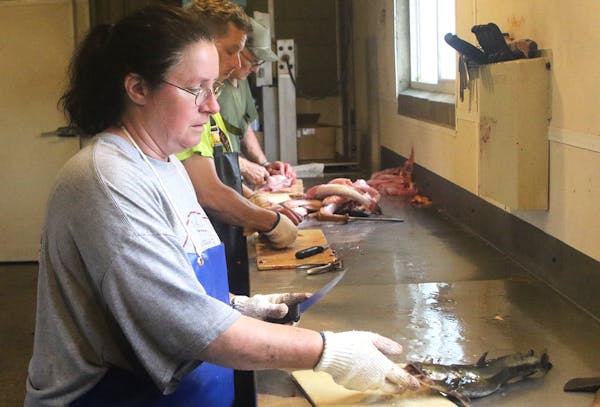NISSWA, MINN. – Fishing these days is either the truest form of escape or a habit that can't be broken. Either way in this part of central Minnesota, the curtains of summer are being pulled back and hooks are being baited. The goal as always is to catch a walleye, sunfish or bass. But the state's troubles, and the nation's sufferings, roil all waters, and boats here, as everywhere, rock.
When Bill Marchel and I planned this outing, we knew we wouldn't be shaking hands. The coronavirus has everyone on the run, he and I no different, and in this case our personal protection equipment would include waders, bait-casting rods and weed-evading lures called Scum Frogs.
Our intention was to catch largemouth bass, a goal shared by increasing numbers of Minnesotans as well as visitors from other states.
"It's been good so far this year," Bill said. "Good, but not great."
As Bill spoke, he and I stood in a ditch bracketed on one side by a long stretch of blacktop and on the other by one of the 646 lakes in Crow Wing County, the latter taking its name from a wing-shaped island at the confluence of the Crow Wing and Mississippi rivers.
Pulling on waders and stringing braided line through the eyes of our fishing rods, we watched as storm clouds gathered. The reference here is literal but, considering the times in which we live, could be metaphorical as well.
From either perspective, a good soaking wouldn't be a bad thing, I thought, given the rebirth it promises. Selfishly, however, Bill and I hoped that rain, the literal kind, and especially thunder and lightning would hold off for a few hours and give our fishing a chance.
Rarely undertaken in Minnesota anymore, except on some Twin Cities lakes, and of course by stream-trout fishermen, wade fishing is as old as the hills.
The Dakota and Ojibwe fine-tuned the practice in springtime using spears and torches and also nets. And after smelt were discovered in Lake Superior in 1946, wading for those tasty morsels gained a cultlike following among North Shore dip netters whose campfires beamed like lighthouses from the mouths of the Lester, Knife, Temperance and other rivers.
But when aluminum fishing boats began to be manufactured after World War II using surplus metal, Minnesota anglers became vastly more mobile, moving more easily not only from lake to lake, but, once on those lakes, to the deeper haunts walleyes and other game fish preferred in midsummer and beyond.
Today, human progress being what it is, the very same largemouth bass Bill and I would chase on foot are often sought by anglers not in two-bit tin rowboats but at the helms of $75,000, gizmo-laden whopper-seekers piloted like fuel-injected dragsters from hot spot to hot spot.
"The advantage we have is that we can get into shallower water than boats can," Bill said, "and the bass won't hear us coming."
With that, Bill reared back on the 8-foot-long graphite wand he held in both hands. Arching like a missile, the chartreuse Scum Frog tied to the end of his line plopped to the watery surface amid a vegetative cocktail of lily pads, hard-stem bulrushes, cattails and wild rice.
Were it not for the wild rice, which was in its lay-down stage, we could have deployed weedless plastic worms or other more typical bass-seducing baits. But the thick cover into which we cast, the rice in particular, made lure retrieval difficult and nigh impossible when a fish was hooked.
Thus the use of weed-evading Scum Frogs.
"Plus," Bill said, "watching a bass come up and hit the Frog is exciting."
Were this a Saturday morning fishing show rather than an old-fashioned print report, snazzy editing and the wizardry of time compression would by now have Bill and me awash in biceps-bulging bass strikes.
But in truth our initial casts yielded only the nibbles of sunfish attempting to punch above their weight, a risky if occasionally rewarding practice that too often exposes its practitioners' weaknesses, those of politicians especially.
Bill's first taker, a black-striped, olive-green specimen, would have tipped the scales between 2 and 3 pounds, had we bothered to weigh it.
Breaking the lake surface once, then again, and tail-walking, the fish tested Bill's stiff rod as it was brought to hand.
Hoisting the bass from its weedy lair to dislodge the bait from its mouth and release it, Bill briefly held the fish. As he did, the world seemed for that long moment to be as it always had, with a prize catch in hand and progress toward some better end for everyone if not guaranteed, at least inexorable.
But perhaps that worldview was an illusion.
Ultimately, lightning chased Bill and me off the lake and we retreated to a nearby eatery, at which we were the establishment's only customers and by government edict were restricted to sitting outside where, beneath an overhang, we stayed mostly dry while being served by a masked waitress.
"If this is the new normal, it's pretty weird," Bill said.
And might be for a while.
As Pema Chödrön, the Buddhist nun, has said: "Nothing ever goes away until it teaches us what we need to know."
Dennis Anderson • danderson@startribune.com

Anderson: Celebrate Earth Day by rekindling real connection to nature
Anderson: Anglers protesting tough new Mille Lacs rules are wrong

Anderson: Courts, not politicians, should rule on Red Lake, White Earth lands

Anderson: Multimillion windfall gets invasive carp deterrent moving
![A young whitetail deer searches for food as another blanket of snow coats the arrowhead. ] Minnesota -State of Wonders, Arrowhead in Winter BRIAN PETE](https://arc.stimg.co/startribunemedia/WK32UWWY6FKNWJUIYCJ6ZPT4AU.jpg?h=91&w=145&fit=crop&bg=999&crop=faces)

